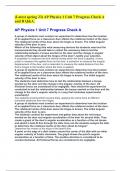Exam (elaborations)
(Latest spring 23) AP Physics 1 Unit 7 Progress Check A and B Q&A.
- Course
- Institution
(Latest spring 23) AP Physics 1 Unit 7 Progress Check A and B Q&A. AP Physics 1 Unit 7 Progress Check A A group of students must conduct an experiment to determine how the location of an applied force on a classroom door affects the rotational motion of the door. The rotational inertia of the...
[Show more]



